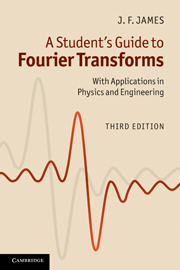Book contents
- Frontmatter
- Contents
- Preface to the first edition
- Preface to the second edition
- Preface to the third edition
- 1 Physics and Fourier transforms
- 2 Useful properties and theorems
- 3 Applications 1: Fraunhofer diffraction
- 4 Applications 2: signal analysis and communication theory
- 5 Applications 3: interference spectroscopy and spectral line shapes
- 6 Two-dimensional Fourier transforms
- 7 Multi-dimensional Fourier transforms
- 8 The formal complex Fourier transform
- 9 Discrete and digital Fourier transforms
- Appendix
- Bibliography
- Index
9 - Discrete and digital Fourier transforms
Published online by Cambridge University Press: 05 June 2012
- Frontmatter
- Contents
- Preface to the first edition
- Preface to the second edition
- Preface to the third edition
- 1 Physics and Fourier transforms
- 2 Useful properties and theorems
- 3 Applications 1: Fraunhofer diffraction
- 4 Applications 2: signal analysis and communication theory
- 5 Applications 3: interference spectroscopy and spectral line shapes
- 6 Two-dimensional Fourier transforms
- 7 Multi-dimensional Fourier transforms
- 8 The formal complex Fourier transform
- 9 Discrete and digital Fourier transforms
- Appendix
- Bibliography
- Index
Summary
History
Fourier transformation is formally an analytic process which uses integral calculus. In experimental physics and engineering, however, the integrand may be a set of experimental data, and the integration is necessarily done artificially. Since a separate integration is needed to give each point of the transformed function, the process would become exceedingly tedious if it were to be attempted manually, and many ingenious devices have been invented for performing Fourier transforms mechanically, electrically, acoustically and optically. These are all now part of history since the arrival of the digital computer and more particularly since the discovery – or invention – of the ‘fast Fourier transform’ algorithm or FFT as it is generally called. Using this algorithm, the data are put (‘read’) into a file (or ‘array’, depending on the computer jargon in use), the transform is carried out, and the array then contains the points of the transformed function. It can be achieved by a software program, or by a purpose-built integrated circuit. It can be done very quickly so that vibration sensitive instruments with Fourier transformers attached can be used for tuning pianos and motor engines, for aircraft and submarine detection and so on. It must not be forgotten that the ear is Nature's own Fourier transformer, and, as used by an expert piano-tuner, for example, is probably the equal of any electronic simulator in the 20–20 000-Hz range.
- Type
- Chapter
- Information
- A Student's Guide to Fourier TransformsWith Applications in Physics and Engineering, pp. 127 - 136Publisher: Cambridge University PressPrint publication year: 2011



